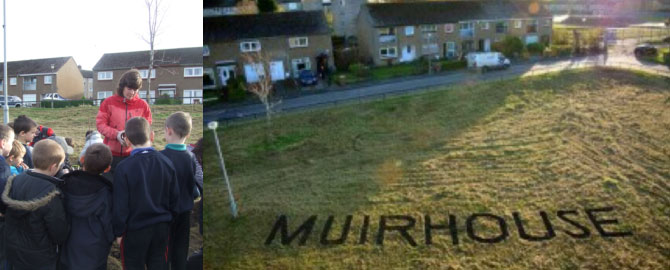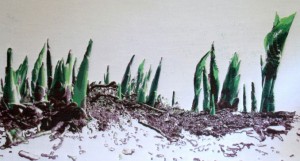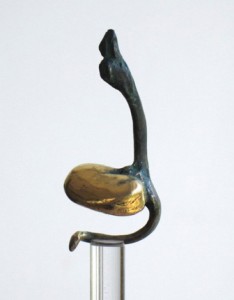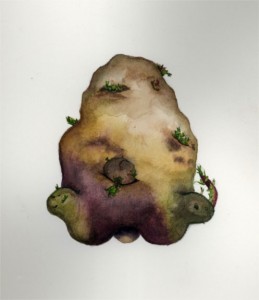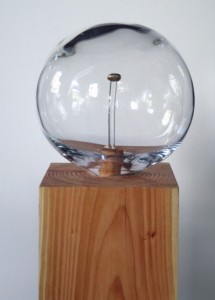Natalie Taylor is a sculptor who is in touch with nature. Her work stems from life, in particular ‘the germinating seed’. Her sculptures are beautifully created; simple and organic forms, which highlight the elegance of the growth of the seeds. Taylor’s work is heavily connected with scientific elements, largely to do with environmental issues. She problem-solves these concerns, upholding a true sense of responsibility to our planet by using recycled, natural and/or locally sourced materials.
Whether wonderfully executed bronze casts, or installations made from rammed earth, wild flower seeds, and timber, her work has a naturally serene and calm ambiance, with a fertile kick. Taylor’s work seems to almost pull itself out of the ground.
In her own words
Describe the steps involved in creating your works.
Often my works will be created in response to a situation, piece of information or particular space. I try to be quite sensitive to the context that a work will be viewed in as I am creating it. More recently, I have become very aware of the environmental impact of certain materials and have started to use more and more natural and organic materials in a temporary way. For example, ‘Earth to Earth’, originally created for an indoor exhibition, then took form two years later as ‘Return’, using the sandy soil of Diessen in Netherlands, locally produced cattle manure, and scavenged acorns from the forest. This, combined with a timber frame made from locally sourced wood, created a temporary sculpture, in harmony with the surroundings.
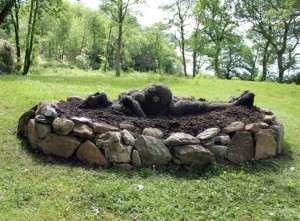
Sited in a quiet part of the fabulous Caol Ruadh Sculpture Garden, Argyll and Bute, this version of the figure is planted with flowering alpines.
In terms of the steps involved with making, I often start with wanting to ask questions. If I am creating a research-led work, for commission or exhibition, I will find out as much as possible about that field, speaking to experts, eg scientists or researchers. If the commission is for a specific location or building, the ‘experts’ are those who are living in it.
Then, over an indefinable ‘germination’ period, an idea will appear. This may take several days or several weeks, so if it’s a tight deadline I just have to be patient! Then the problem-solving period begins. It usually starts with a singling out of materials and techniques, which express the idea I am working with. The making part for me is the most enjoyable, when all the ‘hard work’ of the decision-making is done, and I am on the downward slope of actually producing the object or painting. This is when most major decisions have been made, and I am immersed in the moment-to-moment process of creating.
What exactly do you expect from your audience?
I am not sure it is wise to expect anything from your audience. I think if you are making a self-contained artwork, i.e. one which is not commissioned or in response to a grant etc., then it should be made for the pleasure of making. If people enjoy it then that’s an added bonus.
However, if I am making something to commission, then I am very careful of possible response and try to find out as much as I can about the context for which an artwork is being made. For example, with ‘Cultivating Earth’, (commissioned by Falkirk City Council, in Scotland) I was very happy that the context was a working garden and a space where people were going to be encouraged to reflect on our relationship with the Earth.
For the more controversial works such as the ‘Green Fingers’ and ‘Toes’ series, I was hoping to jolt people into questioning their own relationship with food, their reactions to genetically modified food products and the possible consequences of those, and a general awareness of the complexity of the global food industry.
Now, as I become more interested in community involvement and the public’s engagement in the physicality of creating a new artwork or event, I am becoming excited about how the audience themselves can become empowered by the process.
What do you find most challenging?
At the moment I have two small children, so finding time to make work is the most challenging thing. If I have an exhibition coming up I have to be very careful to spread the work out over several months so that I leave enough time to cover all processes. I work in small bursts of time and in the evenings, so that the process is moving along constantly. The most challenging thing therefore is if I have too many deadlines at once!
Do your early works share a common theme with your lastest pieces?
As a viewer of the website you could be forgiven for thinking that many of the works were by different artists. I have not usually been driven by a materials-based approach, ie starting with the given material and working with that. Rather, because I have mostly been working in a research-led way, I ‘germinate’ the idea initially, and then work backwards to decide on the most appropriate medium or format. However, having said all that, a common theme has most definitely been observation of the minutiae of the natural world, ie, seeds, plants and trees. This for me symbolizes many things about our own personal growth, ie, physical and emotional and spiritual, and is fundamental to our understanding of ourselves.
What influences have driven your work?
When I was an undergraduate, I was absolutely bowled over by three artists. Marina Abramovic, the New-York based Serbian performance artist became the focal point for my thesis. I was intrigued by her use of performed rituals to ‘jolt’ people out of a sense of mundanity and into a world of new possibilities.
Rebecca Horn was also a giant in my mind, in that she had overcome great physical suffering- she was bedridden in her early twenties due to a lung-poisoning and was forced to reconfigure her approach according to her physical abilities. She eventually emerged with new body-art sculptures and organic machines.
And then the video ‘The Way Things Go (Der Lauf der Dinge)’ by Fischli and Weiss with its split-second timing humour and the anarchic combination of objects just blew me away. Those three fuelled over a decade of inspiration for me, where I was producing works that were kinetic, combinations of plant-activated contraptions and physical manifestations of body/plant works.
More recently, reading texts from Eastern philosophy, (‘Tao Te Ching’, ‘Yoga Sutras of Patangali’), and my own yoga practise are having fresh influences on me. My approach and motivation are evolving. I have become more interested in local artists and groups and how they interact with their local environment rather than the globally recognized artists. People who are making real the messages of local living, environmental sensitivity, and harmony with our own localities, such as ‘We Made That’ a London-based architecture group who appropriate found materials and objects to make community spaces. Models for community activism and approach such as ‘Incredible Edible Todmorden’ are also inspiring for me right now. This Yorkshire-based community group founded four years ago have planted edible plants in every available public outdoor space in their town, for all to share for free, making everyone feel involved in a fundamental part of their lives; food.
I feel that the future of my art making may well lie with the collective act, rather than the individual vision. So I see my role moving away from that of creating objects for exhibition or sale. I hope that I will have more opportunities to create temporary and permanent works in conjunction with others, acting as an intermediary and facilitator and connect the ‘non-artist’ with the creative side of themselves. As Joseph Beuys once said, SCULPTURE AS AN EVOLUTIONARY PROCESS; EVERYONE IS AN ARTIST. (1979)
Born 1971, London. Brought up in Edinburgh by violinist parents. After leaving school attended Reading University to study Art History and English, but left before completing degree and returned to Edinburgh where she ran a nightclub for a while. Studied art at Newcastle College of Art and Design (BTEC)1993 and Staffordshire University BA ( Hons ) 1996. Returned to Edinburgh. Won the Royal Scottish Academy’s First time Exhibitor Prize in 2001. Started teaching at Edinburgh College of Art, Sculpture Department. Exhibitions include Wysing Arts; Cambridgeshire, Nordisk Kunstnarsenter; Western Fjords of Norway, Kastellanimaja Galleri ; Estonia, Launceston Church Grammar ; Tasmania, Intermedia; Glasgow. Residencies go as follows:
Wysing Arts, Cambs, UK 1999, Kustraum Zehn; Hanover, Germany 1999, Launceston Church Grammar; Tasmania 2007, Nordisk Kunstnarsenter; Norway 2001, 2003, ‘Patagonia'; Eindhoven, Netherlands, 2009, North Edinburgh Arts; Edinburgh, 2012.
Exhibitions also include Edinburgh Art Festival 2010.
Commissions include Royal Edinburgh Hospital; Edinburgh, Callendar House; Falkirk, Elizabeth Maginnis Court; Edinburgh, National Museums of Scotland, Museum of Rural Life; East Kilbride.
Lives and works freelance in Edinburgh with sculptor husband, Kevin Dagg and their two children.
All images courtesy of Natalie Taylor | www.natalietaylor.org.uk
MUIRHOUSE aerial photographed by: Michael Lindsay
For more information on Hong Kong Art Tutoring please contact:
Gail Deayton
Telephone: +852 9722 8353
Email: gd@gaildeayton.com

